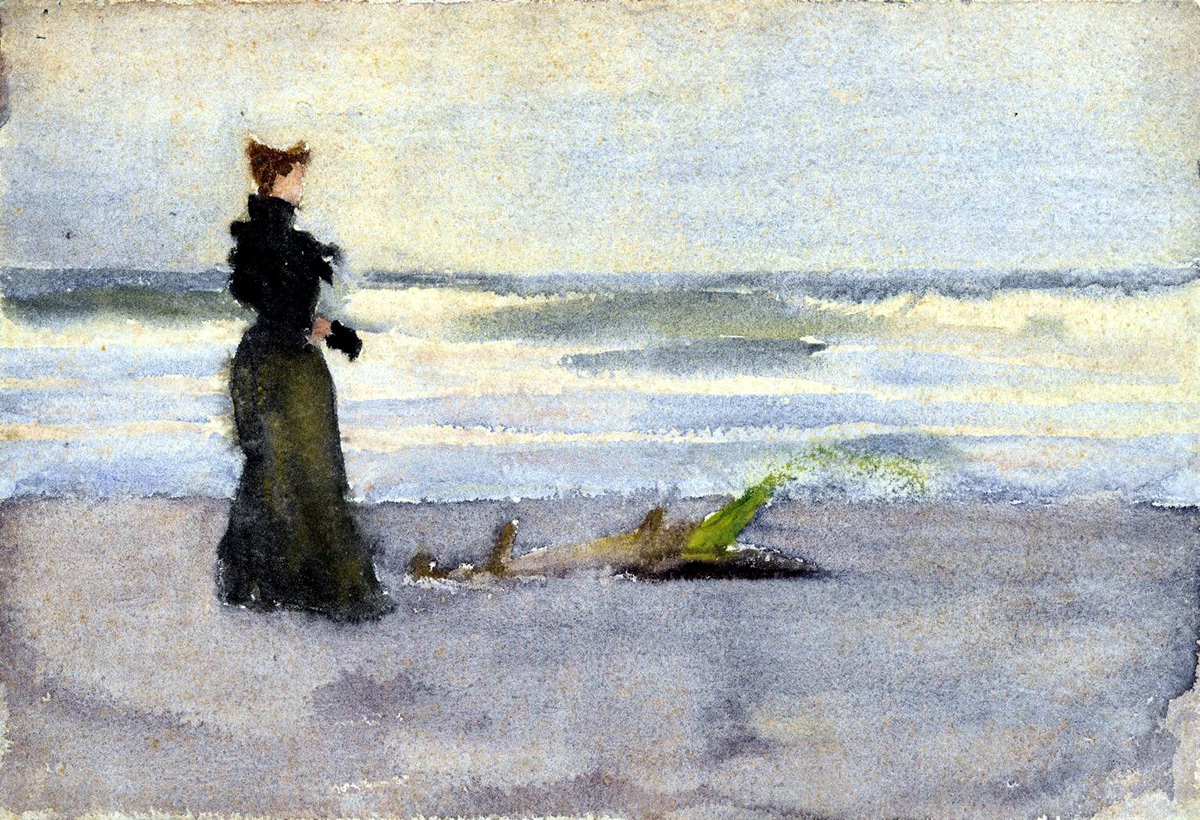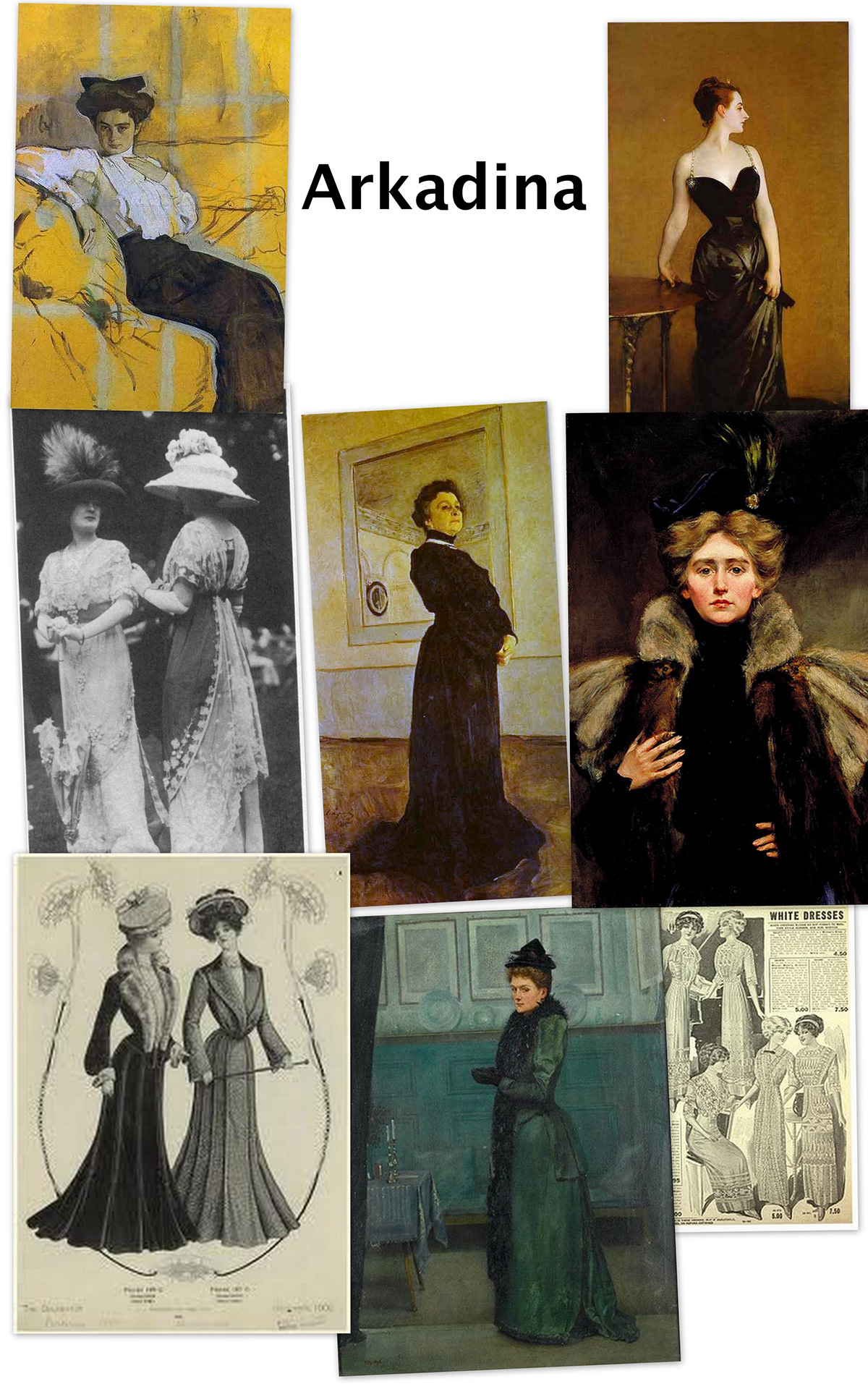Central Image

“The Seagull” by Checkhov is a play about a group of people who, for various individual reasons, wish to be in different circumstances than their own. The characters imagine hypothetical futures in which they are living the ideal and romanticized lives that they see as preferable to their present situations. The costume designs I created for this hypothetical production are representations of how each character wants to be seen. The characters’ desires to present themselves in these costumes is based on the belief that their physical appearances are bringing them a taste of the lives they dream of, even if they have no intentions to actually change anything about where and how they live.
Costume Renderings
Polina, Act 1

Polina is an important member of the household, and is part of the staff that maintains Sorin’s estate. She wears a blouse made of white silk broadcloth with sleaves and a collar made of a cream eyelet with an embroidered abstract bird motif. Her skirt is gourd shaped and made of black du pioni silk. The waist band of the skirt is black dupioni layered by a black mesh with a geometric motif. Her ensemble is based on images I found in my research of governesses, housekeepers, and nannies, as well as the use of texture, rhythm, and variation. I used only two hues, but the outfit consists of four fabrics, all with different textures.

Konstantin, Act 1

Konstantin is preparing for the performance of his play when we first see him in Act one. He is someone who is constantly thinking about either his writing, his mother, Nina, or his jealousy of Trigorin. He has neither the time nor the desire to think about fashion or what he should wear. Most of his wardrobe consists of garments that his mother purchased for him. He is sensitive, emotional, and wants everyone to take him and his work extremely seriously. In this act, he is wearing a navy blue tweed shirt and dark blue houndstooth pants.

Nina, Act 1

In Act one, Nina has just traveled rapidly from her father’s estate which neighbor’s Sorin’s home. She is about to perform Konstantin’s play. Nina is a bit of a free spirit. Konstantin admires her other-worldliness and wild beauty. She comes from a wealthy family, but prefers to wear clothing that allows her to move freely and provides her with a sense of character so that she might act in a way that fits her outfit. She is an actress like Arkadina, but they differ in that Nina is enthusiastic about experiencing all types of art first hand. Being an actress is a craft that she is always working on, but she doesn’t crave being the center of attention the way that Arkadina does. In this Act, she is wearing traditional Russian folk/peasant clothing: a cotton skirt and blouse, both with embroidered detail, a shawl tied around her waist, and lace up boots. Her hair is long, free flowing, and a little messy.


Nina, Act 4

In Act four, years have past. It is winter, and Nina has been wandering the grounds outside Sorin’s house trying to decide whether or not to come in and find Konstantin. She has experienced abandonment and loss. Konstantin left her and she lost the child that he impregnated her with. She is miles and miles from the lively and vivacious young girl that we met in Act one. She is wearing a blue-grey cotton gourd dress that is a bit worn and stained with mud at the bottom. She is wrapped up in a woven shawl with a faded stripe pattern and long fringe. Her hair is in a loose braid slung over her shoulder.

Trigorin, Act 2

In Act two Trigorin is with the rest of the characters having a picnic. He wears a striped suit in two tones of beige, with a checked wool vest, a white shirt, a brown tie, and a Homburg hat. He is wearing clothing that is comfortable and cool, but makes him look distinguished. He has a full beard and a moustache.

Arkadina, Act 2

In Act two, all the characters are enjoying a picnic outside in the summer sun. I chose to put Arkadina in an Edwardian Lingerie Dress. It is light, comfortable, and fashionable. Arkadina is not an ingénue, as she is a bit older that someone like Nina. It would be appropriate for someone her age to be wearing an ivory or off-white dress rather than pure white. Arkadina might be fashionable and intelligent, but she has difficulty accepting that she is not the youngest and most beautiful woman in their group. She has spent many years playing the ingénue in theatrical productions in Moscow, and probably finds it hard to make the transition into playing older women in supporting roles. For all of these reasons, she is wearing a very light cream colored dress, that is still a bit too white for someone as mature as Arkadina. It has many details, and different types of lace which she probably like because it is beautiful, feminine, and distracts from any flaws in her physicality that she might be self-conscious of.
Arkadina, Act 3

In Act three, Arkadina and Trigorin are preparing to leave and return to Moscow because Arkadina is fed up with Konstantin’s behavior. It is the evening so it is cool outside, but it is not particularly cold. Not one to make a subtle entrance or exit, Arkadina is a true thespian and therefore is wearing an elaborate ensemble of a dark blue gourd dress, a fur cape (with three different kinds of fur), and a pink hat with a bright pink feather in it. I believe that she never really intended to leave, but wanted to make a scene and get her son’s attention. She certainly doesn’t need something as warm as a fur cape, but she is performing almost every second of her life, and would not miss an opportunity for an eye-catching costume.



